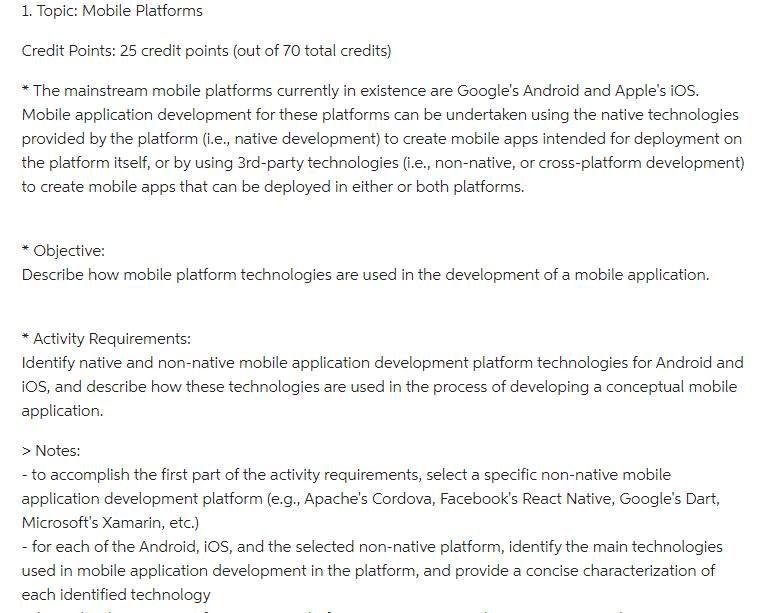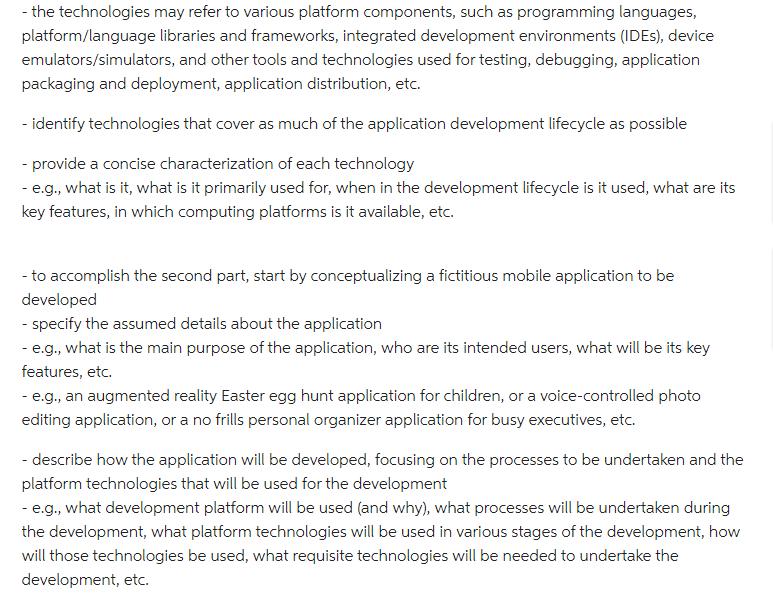Answered step by step
Verified Expert Solution
Question
1 Approved Answer
Topic: Mobile Platforms Credit Points: 25 credit points (out of 70 total credits) * The mainstream mobile platforms currently in existence are Google's Android



Topic: Mobile Platforms Credit Points: 25 credit points (out of 70 total credits) * The mainstream mobile platforms currently in existence are Google's Android and Apple's iOS. Mobile application development for these platforms can be undertaken using the native technologies provided by the platform (i.e., native development) to create mobile apps intended for deployment on the platform itself, or by using 3rd-party technologies (i.e., non-native, or cross-platform development) to create mobile apps that can be deployed in either or both platforms. Objective: Describe how mobile platform technologies are used in the development of a mobile application. * Activity Requirements: Identify native and non-native mobile application development platform technologies for Android and iOS, and describe how these technologies are used in the process of developing a conceptual mobile application. > Notes: - to accomplish the first part of the activity requirements, select a specific non-native mobile application development platform (e.g., Apache's Cordova, Facebook's React Native, Google's Dart, Microsoft's Xamarin, etc.) - for each of the Android, iOS, and the selected non-native platform, identify the main technologies used in mobile application development in the platform, and provide a concise characterization of each identified technology - the technologies may refer to various platform components, such as programming languages, platform/language libraries and frameworks, integrated development environments (IDES), device emulators/simulators, and other tools and technologies used for testing, debugging, application packaging and deployment, application distribution, etc. - identify technologies that cover as much of the application development lifecycle as possible - provide a concise characterization of each technology - e.g., what is it, what is it primarily used for, when in the development lifecycle is it used, what are its key features, in which computing platforms is it available, etc. - to accomplish the second part, start by conceptualizing a fictitious mobile application to be developed - specify the assumed details about the application - e.g., what is the main purpose of the application, who are its intended users, what will be its key features, etc. - e.g., an augmented reality Easter egg hunt application for children, or a voice-controlled photo editing application, or a no frills personal organizer application for busy executives, etc. - describe how the application will be developed, focusing on the processes to be undertaken and the platform technologies that will be used for the development - e.g., what development platform will be used (and why), what processes will be undertaken during the development, what platform technologies will be used in various stages of the development, how will those technologies be used, what requisite technologies will be needed to undertake the development, etc. - e.g., iOS will be used since the application is intended primarily for iPad Pro devices, the Visual Studio Code editor with the Flutter plug-in will be used, the Calabash framework will be used for testing, the OpenGL ES and Media Framework libraries will be used, the developer will have to sign up for a Google Play Console account and pay a one-time $25.00 developer fee, etc.
Step by Step Solution
There are 3 Steps involved in it
Step: 1
The detailed ...
Get Instant Access to Expert-Tailored Solutions
See step-by-step solutions with expert insights and AI powered tools for academic success
Step: 2

Step: 3

Ace Your Homework with AI
Get the answers you need in no time with our AI-driven, step-by-step assistance
Get Started


